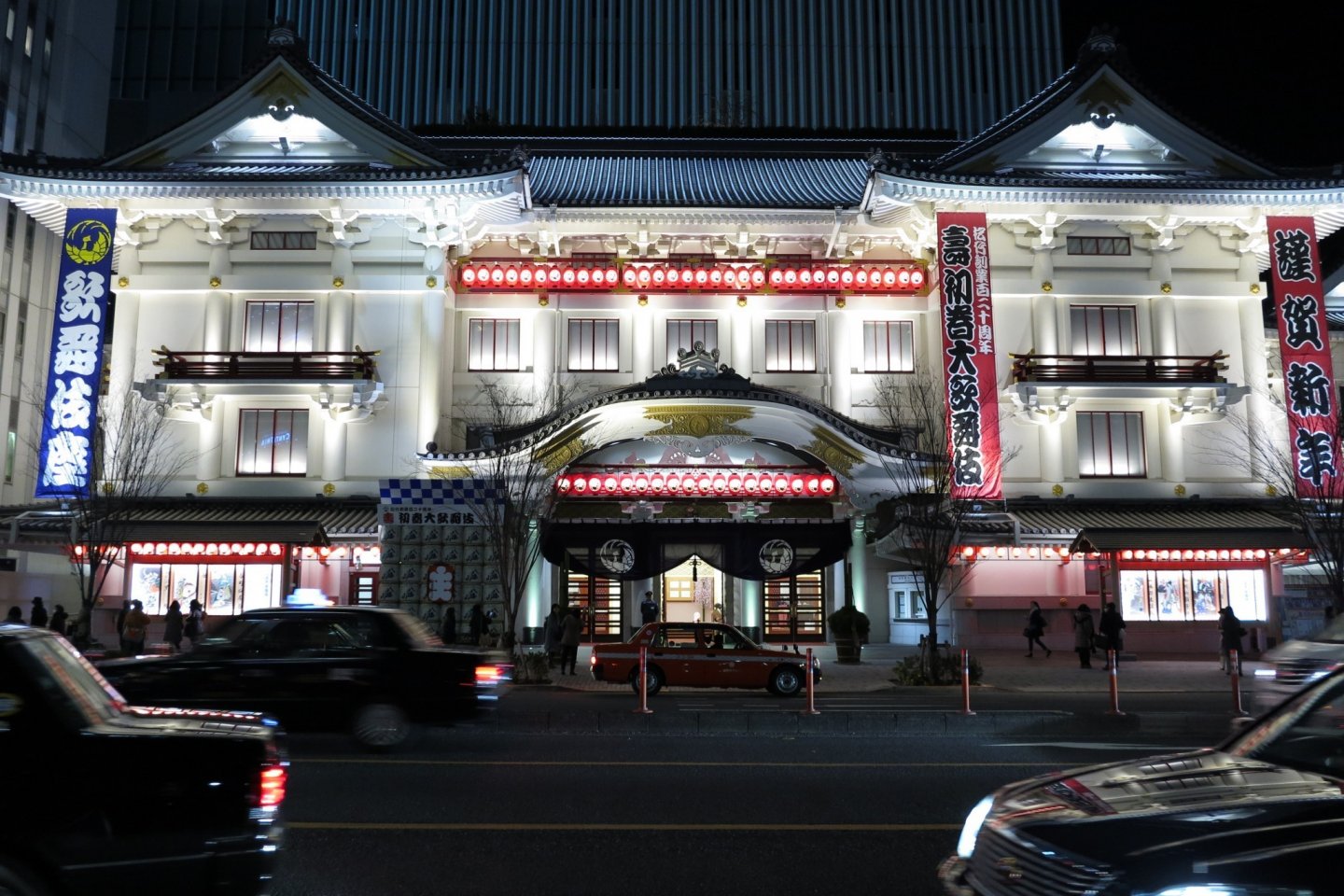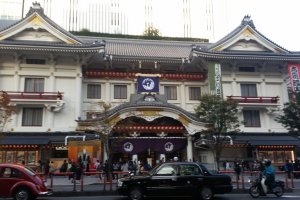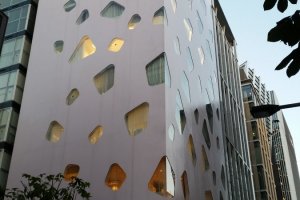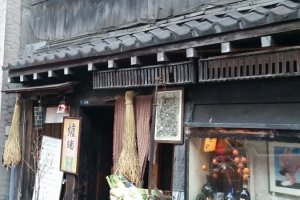In Ginza, the air seems almost scentless, like freshly minted coins. Every day, shopkeepers clean their storefront sidewalks. Immaculately scrubbed and groomed Japanese promenade in fine clothes. There’s no traipsing to the convenience store in a tracksuit here.
With Chanel and Gucci, bars that need reservations and restaurants that require a referral, Ginza can seem impenetrable; a luxury watch behind glass. But it has budget-friendly fashion like Zara, H&M and the world’s biggest Uniqlo. It has noodle joints, casual pubs, even Hooters.
Shopping galore
Department store Wako opened 1894. Customers originally sat on tatami mats as staff brought out goods. Today, Wako has luxury limited edition items and stunning window displays. Near Wako are two more grand department stores, Matsuya and Mitsukoshi. Try to arrive at opening time for the fanfare of music and synchronized staff bowing. Don’t miss their decadent depachika basement food halls.
There are bargain vintage kimonos (Hanamura), wares from famous ceramists (Kuroda Touen), more than 2500 types of chopsticks (Ginza Natsuno), steel art katana swords and weapons (Seiyudo). Itoya (since 1904) was the first shop in the country to sell both Japanese and Western stationary. Look for the giant paperclip.
Kyukyodo began in Kyoto in 1663 and has sold stationary and incense from its Ginza branch on Chuo-dori since 1880. In front is Japan’s current highest land value, a record held for over 30 consecutive years. 32 million yen per square metre.
There’s musical goods (Yamaha flagship store), 12 levels of bridal wear (Kirarito Ginza), secondhand cameras (Ginza Katsumido) or four floors of quality children’s clothes (Ginza Sayegusa, since 1869).
Travel around Japan with Ginza’s and adjacent Yurakucho’s roughly 30 “antenna shops,” stores that promote specific regions with food, craft and tourist information. There are 14 in Kotsukaikan shopping complex.
99% of Japan’s gold leaf is crafted in Kanazawa prefecture. You can buy soft serve topped with gold leaf at this antenna shop. The Okinawa antenna shop celebrates the warm, southern island including its American occupation influences. Staff wear tropical-style shirts and you can try US/Japan hybrid dish, taco rice.
Eating in Ginza
High-end dining includes famous tempura restaurant Ten-Ichi or Michelin-three-star sushi temple Sukibayashi Jiro Honten. There are lots of French, Spanish and Italian choices, even Singaporean with Hainanese chicken rice.
You can visit historic places like Shiseido Parlour, a pioneer in serving treats like soda and ice-cream (opened 1902) or Café Paulista, Japan’s first western coffee shop (1911). Kimuraya was Japan’s first western-style bakery, opened 1869. Its famous creation is the anpan bun, filled with red bean paste.
Visit Rengatai, the birthplace of tonkatsu fried pork cutlet, created 1899. Or try katsu curry (tonkatsu with curry sauce), the invention of Ginza Swiss, opened 1947. The British introduced curry to Japan.
For sweets, you could try chocolate at Le Chocolat De, which uses Japanese ingredients like sansho pepper and yuzu citrus, castella sponge cake at Bunmeido Café Ginza or madeleines at Henri Charpentier Ginza Maison.
My favourite dessert was the kuzukiri from Toraya, a traditional Japanese sweet company from 1600s Kyoto. Use chopsticks to pick up ice cold kuzu arrowroot flour noodles then dip them into wasambonto mitsusugar syrup.
Art and Entertainment
Ginza has more art galleries than any other area in Japan (more than 100) and led the promotion of the Japanese contemporary art scene. Since 1889, Kabuzika Theatre has been the national home of kabuki and a space for other art forms. The first Japanese-made movies were screened here around the early 1900s.
There are more than 300 bars including live jazz havens, elegant cocktail dens and the model train themed Bar Ginza Panorama. Clink steins in the impressive faux-Bavarian Lion Beer Hall (opened 1930). Bar Lupin still lies underground in an alley (opened 1928). Bars were once clandestine operations not proudly displayed.
The Yurakucho district was alive with American soldiers, cinemas, theatres, strip shows and gay bars after WWII. Today, izakaya pubs cluster around and under the rail tracks and many are open 24 hours. They’re a raucous contrast to stately Ginza. You have to shout as trains thunder overhead.
History and Trends
In the early 1600s, Edo (today’s Tokyo) was a group of fishing villages. The Tokugawa shogunate placed a silver coin mint where Ginza stands today. With its proximity to Edo Castle to the north (where The Imperial Palace is today) and neighbouring commercial hub Nihonbashi (still a major business district), this reclaimed marshland was set on its prosperous path.
In this feudal era, rules on appearance according to class applied, such as hair styles and clothing down to kimono sleeve lengths. Daimyo lords and samurai were top of the strata but desires for fashion flowed through society. Trends could start by a courtesan wearing a new colour or the way an actor tied a sash. Commoners would sometimes hide a forbidden fabric on their jacket lining.
After more than 200 years of isolation bar government sanctioned exchanges, Japan was forced open to world trade by America in 1853. The Meiji Restoration started from 1868 when the shogun was toppled and Japan’s new emperor and leaders decided the nation had to westernize, modernize and industrialize to stem domination by foreign powers. The capital moved from Kyoto to Edo (renamed Tokyo).
Western architects were invited to transform Ginza into Japan’s first brick town. Wooden buildings were removed and dirt roads paved. Gas then electric lamps replaced paper lanterns, horse-drawn carriages and trams rattled on streets. Merchants now outclassed samurai, who had to cut off their topknots and hide their swords. The new rich sported top hats and bustle skirts. Leather shoes were a novelty and special inserts were designed to make them squeakier.
Through devastating fire (1872), the Great Kanto Earthquake (1923) and air raid bombings in World War II, Ginza was rebuilt and revitalized again and again. Streets widened to serve as fire breaks. Stone structures shot up including many newspaper offices. Trains brought people from suburbs. They could drink sake in around 60 geisha houses or try imported sensations like wine, whisky, black tea and coffee.
Mirroring Jazz Age Paris and New York, artists, writers and intellectually inclined young people discussed Russian novels and Marx in new bars and cafes. Ginza was Tokyo’s coolest quarter in the early 1900s but its pleasure spots were half empty pre-WWII. They were frowned upon as military fascism grew.
Post-WWII, black markets sold anything from old socks, turnips, pig offal to blood-stained hospital blankets. Then the Economic Miracle soared. The 1980s was the bubble era. Corporate elites splashed yen in clubs with hostesses in silk kimonos or European couture, mink toilet covers and drinks with ice cut from Alaskan glaciers.
Japan’s first McDonalds, Starbucks and Apple Store debut in Ginza. The economy stumbled in the 1990s and today, swanky suburbs like Aoyama and Daikanyama are cutting-edge contenders but Ginza holds its clout. Clothing designer Issey Miyake only displays his full range at his Elttob Tep Ginza store. Swish shopping centre Tokyu Plaza opened 2016.
Ginza is a wild ride through 400 years of history but there’s something even older in a tiny alley. Locals pray to Shinto god Inari at Toyoiwa Inari shrine. The stone foxes symbolise Inari’s messengers. Over thousands of years, Inari has come to represent fertility, business and money, but Shinto is so ancient its origins are unknown. It has no sacred texts. The foxes’ real messages are buried in the primordial mud below this glittering town.
Sources: Ritchie, D., Tokyo Megacity, Tuttle Publishing, Periplus Editions (HK) Ltd, 2010 Goss, R., Tokyo: Capital of Cool, Tuttle Publishing, Periplus Editions (HK) Ltd, 2015 Mansfield, S., Tokyo: A Biography, Tuttle Publishing, Periplus Editions (HK) Ltd, 2016 Ginza Rediscovered, Tokyo Eye 2020 (documentary), NHK (Japan Broadcasting Corporation), 2015






































